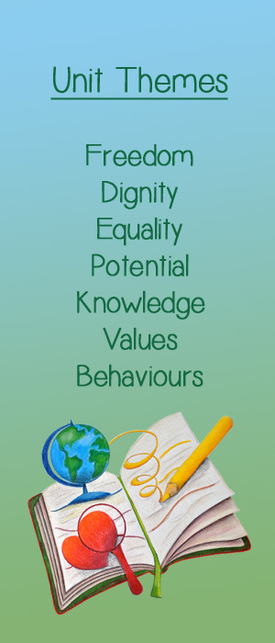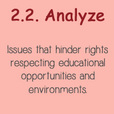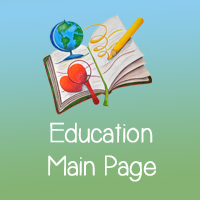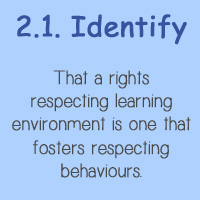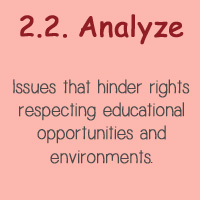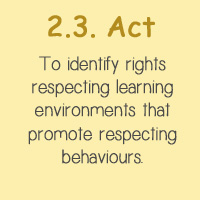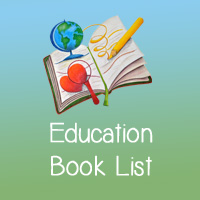Classroom Learning Activities
1. Information to come
Relevant Convention Articles
Article 17
States Parties recognize the important function performed by the mass media and shall ensure that the child has access to information and material from a diversity of national and international sources, especially those aimed at the promotion of his or her social, spiritual and moral well-being and physical and mental health.
To this end, States Parties shall:
(a) Encourage the mass media to disseminate information and material of social and cultural benefit to the child and in accordance with the spirit of article 29;
(b) Encourage international co-operation in the production, exchange and dissemination of such information and material from a diversity of cultural, national and international sources;
(c) Encourage the production and dissemination of children's books;
(d) Encourage the mass media to have particular regard to the linguistic needs of the child who belongs to a minority group or who is indigenous;
(e) Encourage the development of appropriate guidelines for the protection of the child from information and material injurious to his or her well-being, bearing in mind the provisions of articles 13 and 18.
Article 28
1. States Parties recognize the right of the child to education, and with a view to achieving this right progressively and on the basis of equal opportunity, they shall, in particular:
(a) Make primary education compulsory and available free to all;
(b) Encourage the development of different forms of secondary education, including general and vocational education, make them available and accessible to every child, and take appropriate measures such as the introduction of free education and offering financial assistance in case of need;
(c) Make higher education accessible to all on the basis of capacity by every appropriate means;
(d) Make educational and vocational information and guidance available and accessible to all children;
(e) Take measures to encourage regular attendance at schools and the reduction of drop-out rates.
2. States Parties shall take all appropriate measures to ensure that school discipline is administered in a manner consistent with the child's human dignity and in conformity with the present Convention.
3. States Parties shall promote and encourage international cooperation in matters relating to education, in particular with a view to contributing to the elimination of ignorance and illiteracy throughout the world and facilitating access to scientific and technical knowledge and modern teaching methods. In this regard, particular account shall be taken of the needs of developing countries.
Article 29
1. States Parties agree that the education of the child shall be directed to:
(a) The development of the child's personality, talents and mental and physical abilities to their fullest potential
(b) The development of respect for human rights and fundamental freedoms, and for the principles enshrined in the Charter of the United Nations;
(c) The development of respect for the child's parents, his or her own cultural identity, language and values, for the national values of the country in which the child is living, the country from which he or she may originate, and for civilizations different from his or her own;
(d) The preparation of the child for responsible life in a free society, in the spirit of understanding, peace, tolerance, equality of sexes, and friendship among all peoples, ethnic, national and religious groups and persons of indigenous origin;
(e) The development of respect for the natural environment.
2. No part of the present article or article 28 shall be construed so as to interfere with the liberty of individuals and bodies to establish and direct educational institutions, subject always to the observance of the principle set forth in paragraph 1 of the present article and to the requirements that the education given in such institutions shall conform to such minimum standards as may be laid down by the State.
States Parties recognize the important function performed by the mass media and shall ensure that the child has access to information and material from a diversity of national and international sources, especially those aimed at the promotion of his or her social, spiritual and moral well-being and physical and mental health.
To this end, States Parties shall:
(a) Encourage the mass media to disseminate information and material of social and cultural benefit to the child and in accordance with the spirit of article 29;
(b) Encourage international co-operation in the production, exchange and dissemination of such information and material from a diversity of cultural, national and international sources;
(c) Encourage the production and dissemination of children's books;
(d) Encourage the mass media to have particular regard to the linguistic needs of the child who belongs to a minority group or who is indigenous;
(e) Encourage the development of appropriate guidelines for the protection of the child from information and material injurious to his or her well-being, bearing in mind the provisions of articles 13 and 18.
Article 28
1. States Parties recognize the right of the child to education, and with a view to achieving this right progressively and on the basis of equal opportunity, they shall, in particular:
(a) Make primary education compulsory and available free to all;
(b) Encourage the development of different forms of secondary education, including general and vocational education, make them available and accessible to every child, and take appropriate measures such as the introduction of free education and offering financial assistance in case of need;
(c) Make higher education accessible to all on the basis of capacity by every appropriate means;
(d) Make educational and vocational information and guidance available and accessible to all children;
(e) Take measures to encourage regular attendance at schools and the reduction of drop-out rates.
2. States Parties shall take all appropriate measures to ensure that school discipline is administered in a manner consistent with the child's human dignity and in conformity with the present Convention.
3. States Parties shall promote and encourage international cooperation in matters relating to education, in particular with a view to contributing to the elimination of ignorance and illiteracy throughout the world and facilitating access to scientific and technical knowledge and modern teaching methods. In this regard, particular account shall be taken of the needs of developing countries.
Article 29
1. States Parties agree that the education of the child shall be directed to:
(a) The development of the child's personality, talents and mental and physical abilities to their fullest potential
(b) The development of respect for human rights and fundamental freedoms, and for the principles enshrined in the Charter of the United Nations;
(c) The development of respect for the child's parents, his or her own cultural identity, language and values, for the national values of the country in which the child is living, the country from which he or she may originate, and for civilizations different from his or her own;
(d) The preparation of the child for responsible life in a free society, in the spirit of understanding, peace, tolerance, equality of sexes, and friendship among all peoples, ethnic, national and religious groups and persons of indigenous origin;
(e) The development of respect for the natural environment.
2. No part of the present article or article 28 shall be construed so as to interfere with the liberty of individuals and bodies to establish and direct educational institutions, subject always to the observance of the principle set forth in paragraph 1 of the present article and to the requirements that the education given in such institutions shall conform to such minimum standards as may be laid down by the State.
Online Resources and References
Association for Childhood Education International - Promoting and supporting the optimal education, development, and well-being of children worldwide through professional growth of educators and the efforts of others who are committed to the needs of children in a changing society.
Equitas - Educate. Empower. Change: Advancing equality, social justice, and respect for human dignity in Canada and around the world through education.
Humanium Help the Children - Right to Education: Understanding children's right to education
Global Campaign for Education United States Chapter - Student Toolkit for Advocacy - The Global Campaign for Education, US (GCE-US) is a broadbased coalition of US organizations including faith-based groups, non-governmental organizations (NGOs), teachers unions, foundations, and scholars dedicated to ensuring greater access to quality basic education for children in developing nations. GCE-US promotes access to quality education as a basic human right and aims to mobilize the public to create political will in the US and internationally to improve educational opportunities for the world’s poorest children. As a coalition, we also work to promote greater awareness of the importance of pre-school education, eliminate gender disparity in primary and secondary education, increase adult literacy rates, and prevent abusive child labor.
The Global Campaign for Education (GCE) was founded in 1999 and is based in Johannesburg, South Africa. GCE brings together major nongovernmental organizations (NGOs), teachers’ unions, and other civil society groups in more than 100 countries. GCE-US is an independent secretariat of GCE.
Malala Yousafzai Fund - Investing in Innovative and Effective Education Projects: Educate and Empower Girls around the World.
The Green Belt Movement - Empowering communities to conserve the environment and improve livelihoods.
UNESCO - United Nations Educational, Scientific, and Cultural Organization - The Right to Education
Youth for Human Rights - The Right to Education
Equitas - Educate. Empower. Change: Advancing equality, social justice, and respect for human dignity in Canada and around the world through education.
Humanium Help the Children - Right to Education: Understanding children's right to education
Global Campaign for Education United States Chapter - Student Toolkit for Advocacy - The Global Campaign for Education, US (GCE-US) is a broadbased coalition of US organizations including faith-based groups, non-governmental organizations (NGOs), teachers unions, foundations, and scholars dedicated to ensuring greater access to quality basic education for children in developing nations. GCE-US promotes access to quality education as a basic human right and aims to mobilize the public to create political will in the US and internationally to improve educational opportunities for the world’s poorest children. As a coalition, we also work to promote greater awareness of the importance of pre-school education, eliminate gender disparity in primary and secondary education, increase adult literacy rates, and prevent abusive child labor.
The Global Campaign for Education (GCE) was founded in 1999 and is based in Johannesburg, South Africa. GCE brings together major nongovernmental organizations (NGOs), teachers’ unions, and other civil society groups in more than 100 countries. GCE-US is an independent secretariat of GCE.
Malala Yousafzai Fund - Investing in Innovative and Effective Education Projects: Educate and Empower Girls around the World.
The Green Belt Movement - Empowering communities to conserve the environment and improve livelihoods.
UNESCO - United Nations Educational, Scientific, and Cultural Organization - The Right to Education
Youth for Human Rights - The Right to Education
